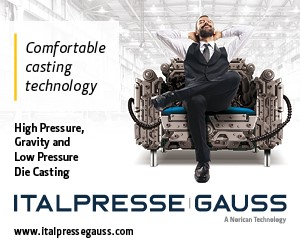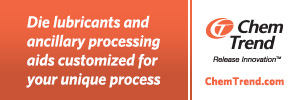The element aluminum (Al) has a specific gravity of 2.7, placing it among the light-weight structural metals. It is used as a base for die casting alloys with three primary constituents: silicon, copper and magnesium. Eight available aluminum die casting alloys give the designer the widest choice among the four primary alloy groups, and they account for the majority of die castings in terms of tons of components produced.
Seven of the eight alloys are based on the aluminum-silicon system. The eutectic (system) composition, 11.7% silicon, is a convenient reference point for grouping them. The seven alloys are further grouped as either controlled copper content or restricted copper content. Other major alloying elements in the aluminum-silicon system are magnesium and iron. Some constituents are considered impurities, and maximum limits, expressed as a single number, are imposed. Alloy 518, with a very low silicon content, is based on the aluminum-magnesium system. All eight aluminum alloys are grouped according to silicon and copper contents in Table 4.2, Aluminum Alloys by Silicon and Copper Content.
Table 4.2 Aluminum Alloys by Silicon and Copper Content
| Silicon | Copper Controlled | Copper Restricted |
|---|---|---|
| Al-Si System Less than 11.7% (Hypoeutectic) |
380, 383, 384 | 364, 443 |
| Nominal 11.7% (Eutectic) |
413 | |
| More than 11.7% (Hypereutectic) |
390 | |
| Al-Mg System 0.35% mx. silicon |
518 |
The comparative die casting and product characteristics of these alloys are shown in Table 4.3 Comparative Characteristics of Aluminum Die Casting Alloys. The designation 1 indicates most desirable; 5 indicates least desirable.
Table 4.3 Comparative Characteristics of Aluminum Die Casting Alloys
| Alloy | ||||||||
|---|---|---|---|---|---|---|---|---|
| Die Casting Characteristics: | 360 | 380 | 383 | 384 | 390 | 413 | 443 | 518 |
| Approx. Melting Range ºF A |
1035-1105 | 1000-1100 | 960-1080 | 690-1080 | 945-1200 | 1065-1080 | 1065-1170 | 995-1150 |
| Resistance to Hot Cracking | 1 | 2 | 1 | 2 | 3 | 1 | 3 | 5 |
| Die-Filling Capacity B |
3 | 2 | 1 | 1 | 1 | 1 | 4 | 5 |
| Anti-Soldering to the Die C |
2 | 1 | 2 | 2 | 3 | 1 | 4 | 5 |
| Product Characteristics: | ||||||||
| Pressure Tightness | 2 | 2 | 2 | 2 | 3 | 1 | 3 | 5 |
| Corrosion Resistance D |
2 | 4 | 3 | 5 | 4 | 2 | 2 | 1 |
| Machining E |
3 | 3 | 2 | 3 | 5 | 4 | 5 | 1 |
| Polishing F |
3 | 3 | 3 | 3 | 5 | 5 | 4 | 1 |
| Electroplating G |
2 | 1 | 1 | 2 | 4 | 3 | 2 | 5 |
| Anodizing (Appearance) H |
3 | 3 | 3 | 4 | 5 | 5 | 2 | 1 |
| Anodizing (Protection) I |
3 | 4 | 4 | 5 | 5 | 3 | 2 | 1 |
| Strength at Elevated Temp. J |
1 | 3 | 2 | 2 | 2 | 3 | 5 | 4 |
| Resistance to Wear | 2 | 3 | 2 | 2 | 1 | 2 | 4 | 4 |
Sources: ASTM B85-92a; ASM; SAE a Ability of alloy to withstand stresses from contraction while cooling through hot-short or brittle temperature ranges. b Ability of molten alloy to flow readily in die and fill thin sections. c Ability of molten alloy to flow without sticking to the die surfaces. Ratings given for anti-soldering are based on nominal iron compositions of approximately 1%. d Based on resistance of alloy in standard type salt spray test. e Composite rating based on ease of cutting, chip characteristics, quality of finish, and tool life. f Composite rating based on ease and speed of polishing and quality of finish provided by typical polishing procedure. g Ability of the die casting to take and hold an electroplate applied by present standard methods. h Rated on lightness of color, brightness, and uniformity of clear anodized coating applied in sulfuric acid electrolyte. i Rated on combined resistance of coating and prolonged heating at testing temperature.
Table 4.3 is based on ASTM B85 except for 390, which is based on judgment from experience. The ratings make comparisons among aluminum die castings only and do not reflect relative characteristics of other metal alloys.
Product Applications
Alloy 380 is the workhorse of the aluminum alloys. It is most often specified because it offers the best combination of casting and product properties. It is used for the widest variety of products such as lawn mower housings, chassis for electronic equipment, engine brackets, cases for automotive drive lines, home appliances, furniture, hand tools and power tools.
Alloys 383 and 384 are alternatives to 380 that are specified when very intricate components require improved die filling characteristics and improved resistance to hot cracking.
Alloy 360 offers high corrosion resistance and superior strength at elevated temperatures than 380. Other properties are essentially equivalent.
Alloy 443 offers the highest ductility of the aluminum die casting alloys.
Alloy 413 offers excellent pressure tightness, making it the choice for products such as hydraulic cylinders and pressure vessels. Its casting characteristics make it useful for very intricate components.
Alloy 390 was developed for automotive engine blocks. Resistance to wear is excellent, but ductility is the lowest of the die casting alloys, with elongation less than 1%. Surface treatment systems allow engine pistons to run directly on the alloy, negating the need for iron liners. It is also used for valve bodies and bearing surfaces subject to abrasion and wear. Two other aluminum alloys, 361 and 369, are being utilized in limited applications where vibration and wear are of concern.
Alloy 518 is used in escalator components, conveyor components, and marine and aircraft hardware fittings. It offers good ductility, and very good corrosion resistance. It can be polished and anodized for a decorative finish.
Heat Treatment & Welding
Aluminum alloy die castings are not usually solution heat treated. Low-temperature aging treatments may be used for stress relief or dimensional stability. A T2 or T5 temper may be given to improve properties. Because of the severe chill rate and ultra-fine grain size in die castings, their as-cast and structure approaches that of the solution heat-treated condition. T4 and T5 temper results in properties quite similar to those which might be obtained if given a full T6 temper.
As stated above, aluminum alloy die castings are not usually heat treated; however, there are heat treatable specialty alloys available for structural applications, such as the Silafonts and AA365. Die castings are not generally gas or arc welded or brazed; however, developments in high integrity die casting processes coupled with specialty alloys has enabled the successful welding of die castings in specific applications. Contact your die caster or alloy producer for more information.
Silicon in Aluminum
As silicon content in aluminum alloys approaches 11.7%:
- Fluidity of the liquid metal increases
- Solidification shrinkage decreases
- Pressure tightness improves
- Hot shortness (tendency to crack or tear during solidification) is reduced
- Modulus of elasticity increases (stiffness increases)
- Specific gravity decreases (silicon is less dense than aluminum)
- Thermal expansion decreases
- Corrosion resistance improves
As silicon content is increased above 11.7% to approximately 17% (the nominal composition for alloy 390), fluidity and wear resistance increase significantly due to the presence of primary silicon in the alloy.
Silicon contributes to fluidity largely due to its high heat of crystallization. When silicon solidifies, it releases a large amount of heat, reheating the remaining liquid aluminum, delaying solidification and allowing the mass to continue flowing. Fluidity contributes to castability, but does not translate directly. Die casting process parameters, such as liquid alloy temperature and micro-cleanliness, die temperature, and die surface conditions are also important.
Copper in Aluminum
Copper content is controlled to improve desirable characteristics, and restricted to reduce others, particularly atmospheric corrosion. Copper content, in the range of 2.0% to 3.0%, increases tensile strength and hardness and improve mechanical properties at elevated temperatures. In these concentrations it marginally influences alloy density. (Copper is more than three times as dense as aluminum.)
The principal disadvantage of copper in Al-Si-Cu alloys, as noted above, is the marked effect of corrosion resistance. Corrosion resistance increases or decreases inversely with copper content, especially at very low levels. Alloys are commercially available with reduced specified maximum copper contents of 0.40%, 0.30%, and 0.20%. These alloys typically carry a cost premium.
Magnesium in Aluminum
Magnesium is controlled to relatively low levels in most aluminum-silicon alloys; generally, 0.10%. Higher concentrations, particularly above 0.30%, tend to reduce ductility, and in extreme cases, embrittlement may occur. Precise control of magnesium content within the specified range, however, can enhance chip formation and removal in machining operations.
Magnesium is a controlled addition (0.45% to 0.60%) in alloy 360. It contributes to strength and hardness, which are otherwise lost by the restricted copper content (0.60%, max). It is also added to alloy 390 to increase hardness.
Alloy 518 differs from the aluminum-silicon alloys in that its composition is based on the aluminum-magnesium system. Alloy 518 and its derivatives offer relatively high ductility and excellent finishing characteristics. Special handling is required to control the selective oxidation of the magnesium phase when in the liquid conditions.
Iron in Aluminum
Iron is necessary in aluminum die casting alloys because iron-free liquid aluminum alloy aggressively attacks ferrous metals, including die steels, causing severe erosion. Aluminum also tends to stick, or solder, onto die surfaces. Iron in aluminum die casting alloys, in the range of 0.60% to 1.20%, tends to prevent these conditions and helps to inhibit hot-shortness.
Iron is essentially insoluble in solid aluminum and is generally limited in specified alloy composition to a restricted maximum amount. In aluminum alloy microstructure, iron occurs as an inter-metallic compound that forms as needles or platelets. The particles tend to affect ductility adversely and often act as fracture initiation sites. The iron-aluminum inter-metallic phase can be altered to a more benign state when manganese and chrome are present.
Manganese & Zinc in Aluminum
Manganese has limited solid solubility in aluminum. Its primary purpose is to modify the iron-aluminum inter-metallic phase described above.
Because zinc has a wide solid solubility range in aluminum, it can be introduced without difficulty. Zinc is limited to restricted maximum amounts in commercial aluminum die casting alloys; generally 0.5% to 3.0%. Zinc provides some solution-strengthening effects, and concentrations within specified ranges have positive influence on machinability. However, excessive amounts of zinc induce cracking tendencies.








